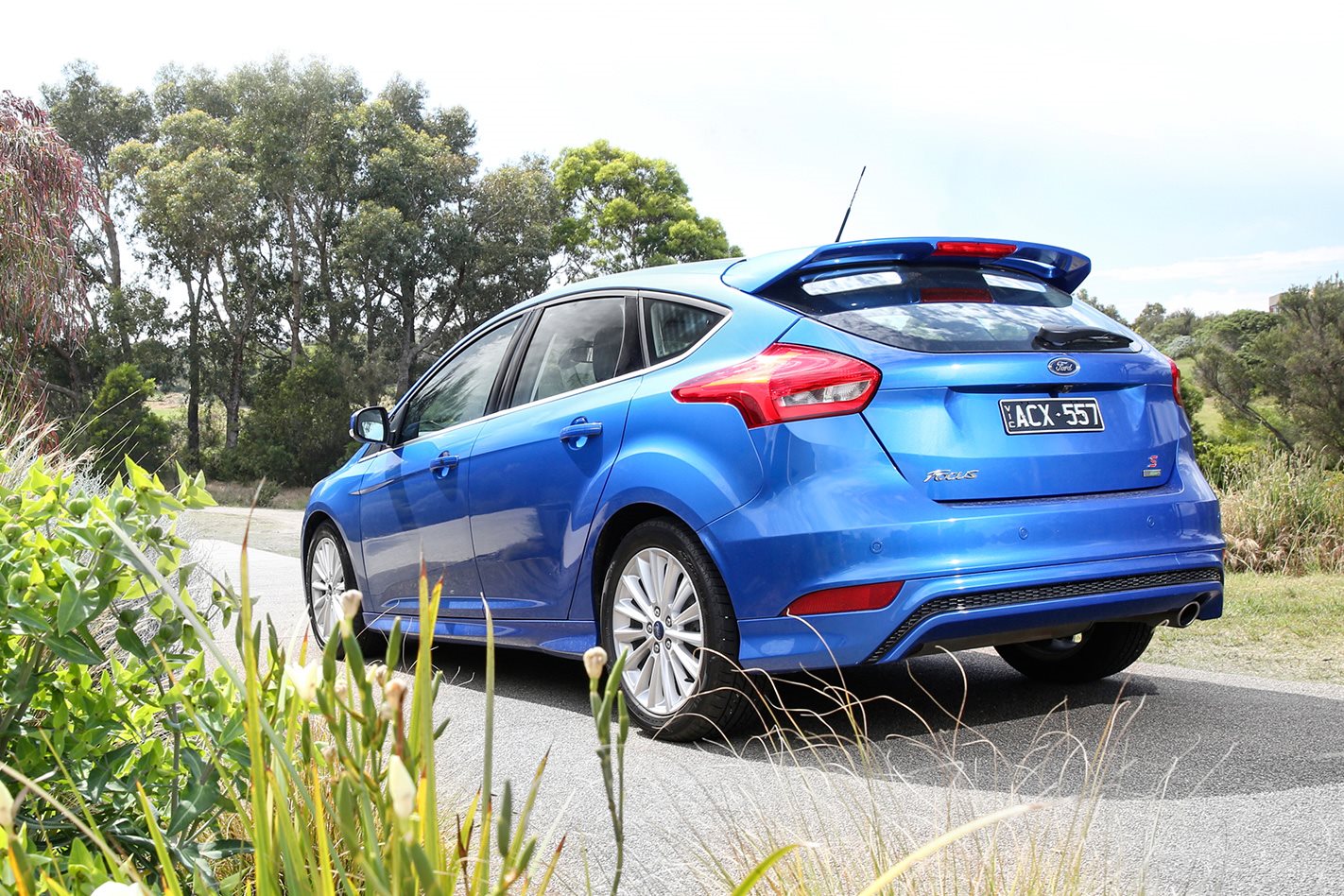- Introduction: A return to form
- Update 1: Winning formula
- Update 2: Routing drama
- Update 3: Inflated worth
- Update 4: Conclusion
Introduction: A return to form
“IT’S a blue Ford Focus,” I say to the lady at the airport parking desk. “Is that the new one?” she asks. “Well, yeah, it’s been updated with a new nose and the inside’s a bit better too.”
I thought Ms Valet was just being polite discussing my new long-termer, but she had a genuine query. “Have they changed the engine?” she said, before adding, “My sister has one, and she’s taken it back twice, and it’s not even one year-old yet.”
Turns out that her sis has the previous LW series Focus, whose problems have been firmly addressed with the late 2015 update to LZ model designation.
The big issue for the Focus was the previous dual-clutch transmission. To summarise, it was rubbish. Recalled, rectified and now written-off, Ford Oz went back to basics with the Thai-built LZ, ditching the dual-clutcher for a conventional automatic. Yet we won’t have that problem: our long-termer has three-pedals and a six-speed manual gearbox (hooray!).

This is the mid-spec Ford Focus Sport hatchback, which at $26,490 sits above the entry-level Ambiente and below the luxed-up Titanium. Not only does my long-termer have the new trapezoidal nose, flanked by LED DRLs, but a smarter, less cluttered interior as well. Standard gear is impressive and includes SYNC2 voice activation for the sat-nav, keyless entry and start, Bluetooth and a crisp colour reversing camera.
Ford used to be the small car kings. Think Cortina, Escort and Laser. Let’s not forget the smaller Fiesta’s skills – especially the current model’s considerable talent. Then there’s the first-gen Focus, which on the cover of one British rag was headlined, ‘Ford is Revolting’. It stuck with me, that cover. So did the car.
Focus, the original, showed a progressive, bold and capable Ford at its absolute best. ‘Kinetic’ design language, high tail-light treatment that kick-started a load of copycat rumps, control-blade suspension and Richard Parry-Jones’ dynamics. That bloke was – is – a legend for making cars like that first Focus push rivals, including the Volkswagen Golf, to up their game.
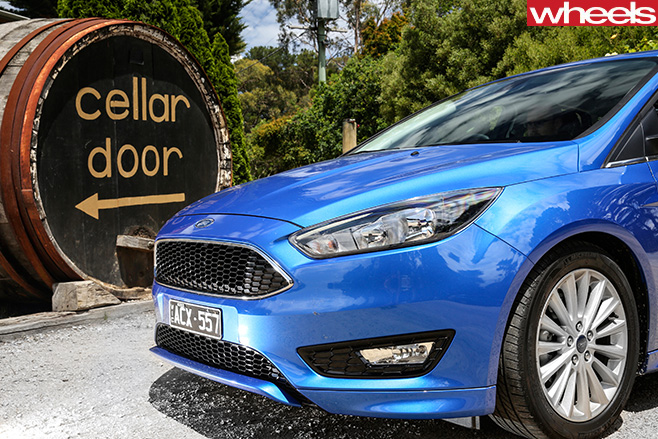
Enter Old Bluey, born on the mean streets of Bangkok. Like any Aussie tourist, my new long-termer may as well be wearing a Bintai singlet. Aussie-Focus supply has been coming from Thailand since 2012, a long way from the quality award-winning German factory for Mk I. That’s what this Sport, now sitting in the valet car park, has to live up to.
My one complaint looking back at the blue Focus is those alloy wheels. I reckon its old-man fuddy-duddy 17s should be on the Titanium, and the Titanium’s hot 18-inch five-spokers should be on the Sport.
There’s little time to explain this to Ms Valet, though. “It’s a cute car, isn’t it,” she chuckles, “and that’s all I care about – not the engine”. Well, Ms Valet, with that new nose and EcoBoost powerplant, my Focus Sport should appeal to you and your sis. Let’s see if it can appeal to the Wheels crew over the coming months more than its predecessor, too.
Third time a charm?
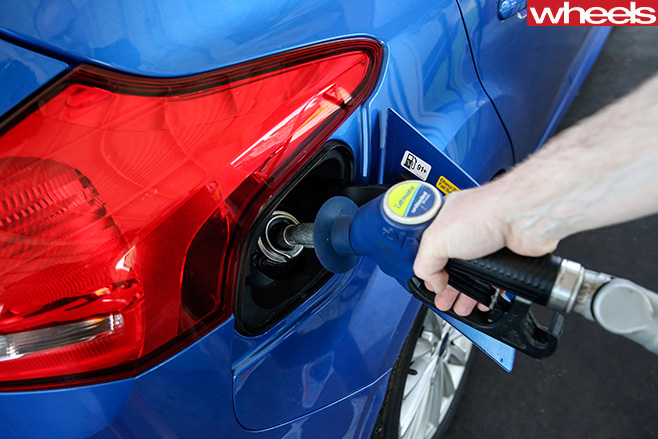
There’s more gear now: paddle shifts are offered for the first time, Active Park Assist now includes ‘Perpendicular Parking’, and a reversing camera is now standard, as is keyless entry and push-button start. Robbo had no complaints about the quality of the Thai-built Focus, and lauded the steering calibration, which has been changed for this LZ model. His only complaint was that sketchy transmission, which won’t be an issue for our manual machine.
Ford Focus Sport hatch Price as tested: $26,910 Part 1: 203km @ 7.4L/100km Overall: 203km @ 7.4L/100km Odometer: 3222km Date acquired: December 2015
Update 1: Winning formula
Taking the alternate choice redefines ‘winning’.
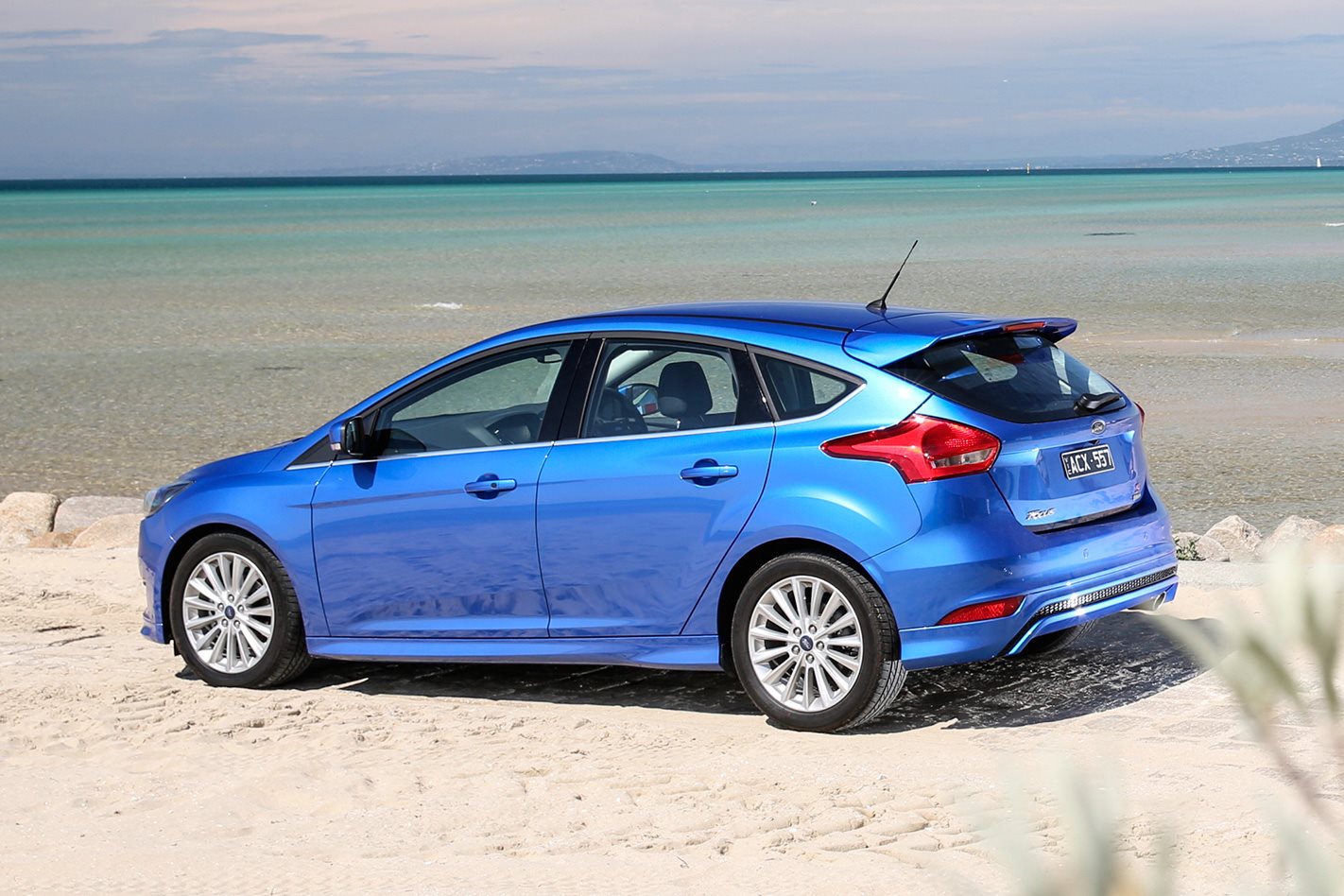
I’LL admit the Focus wasn’t the first choice for our summer beach trip. It wasn’t a lightweight roadster like the luscious red Mazda MX-5 that also sat out the front. But it boasted four fully inflated tyres (the Mazda didn’t) and even a space-saver spare in the boot (again, the MX-5 failed to oblige, but more on that next month when I reveal how the editor’s new long termer started its life at Wheels in my care).
The fact we had a pure driver’s car marooned at home, and one of the world’s most amazing coastlines to explore, had us initially lamenting the more humble hatchback. So we loaded up the ‘Winning Blue’ Ford – feeling far from having won – before the three-hour drive to Port Fairy on Victoria’s glorious Shipwreck Coast.
Immediately, though, the Focus showed its skills as one of the best C-segment hatches. I love driving holidays because there’s no carry-on limit, so I overpack.
On the road, my girlfriend – who comments on cars as much as Donald Trump comments on equality – said, “It’s good that there are two USB slots,” allowing my smartphone to feed while hers spun tunes. We also used something else the MX-5 lacks, a CD player. The Focus stereo, operated via the steering wheel, isn’t outstanding, but it’s far from disappointing.
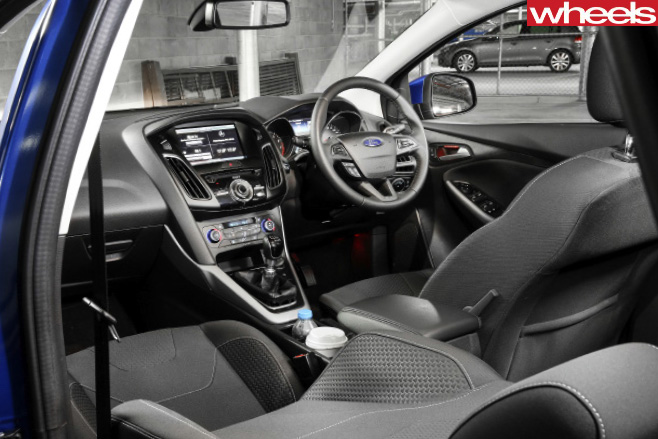
Along the way, the Focus’s seats proved supportive even after several hours, and the air-con blasts cool air to easily deal with 40-degree summer days. Oddly, though, it’s either blasting or doing not much at all; there’s no ‘soft’ setting when you’re after a zephyr. Above the vents, that expansive dashboard proved a great place to dry clothes after a beach swim, but the windscreen reflections wouldn’t budge.
On the winding stuff, where I thought I’d miss the MX-5 most, the Focus didn’t disappoint. Its poise on the sinewy Skenes Creek Road through the Otways, where we’d been diverted after a beautiful trip down the Great Ocean Road because of the Lorne bushfire, was brilliant. The Michelin rubber is the weak link; they’re made more for smooth ride and quietness than out-and-out cornering, the fronts scrubbing easily.
Yet the warbling grunt of that 1.5-litre turbo, slick six-speed manual and overall balance made it a hoot through the forest, where I forgot about the MX-5. Almost.
Summertime, and the living is easy
The Focus proved easy to live with on holiday. The keyless entry – and start – made loading luggage easy, as did the impressive global closing, which winds up all the windows from the key fob as you walk away; a neat party trick. The cloth seat trim cleans up with a mere wipe and the 60/40 split rear seat means easy access to valuables hidden in the boot, which is huge. There’s also loads of space up front for phones, wallets, coffee cups and water bottles, as well as a deep centre console.
Ford Focus Sport Price as tested: $26,910 Part 2: 3096km @ 8.0L/100km Overall: 3299km @ 8.0L/100km Odometer: 6318km Date acquired: December 2015
Update 2: Routing drama
Ignorance is bliss when the traffic warning system doesn’t work in congestion.
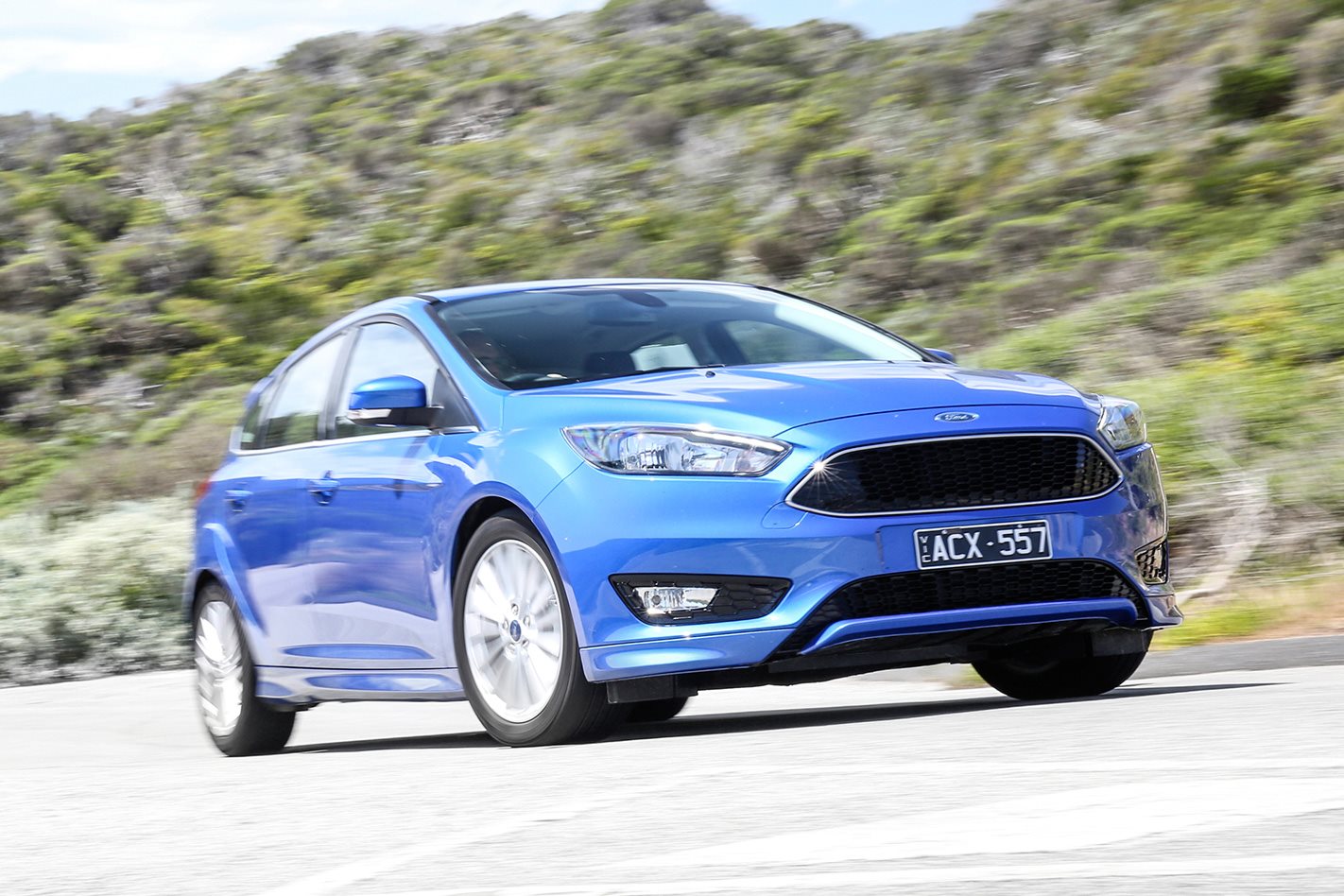
FORGET the hot new Ford Focus RS coming this way – it’s the more practical things about the Focus Sport that I’m starting to know well, and most of its systems are truly excellent. Most.
The sat-nav’s traffic alert system is surely intended to save large chunks of time. I haven’t had a lot of faith in these systems, often being stuck in a traffic jam before a robot’s voice says, “There are traffic delays on your route”. If it’s going to state the obvious it may as well say, “You’re driving a car” or “The capital of Peru is Lima”.
So I had to test the Focus’s traffic system for BS. On Melbourne’s Monash Freeway, the Sport’s nav told me to take the Burke Road exit to avoid queues further ahead. Bugger that; I kept on going. About 25 seconds later, stationary traffic. Game over. The nav was right. It’s the first time I’ve ever been glad to see a heavily congested road ahead.
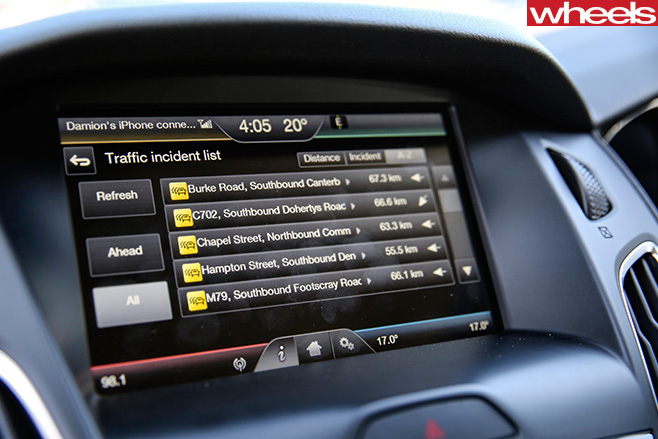
All is well – for about three seconds – before the system reveals that it doesn’t work in a congested city. Just after you’ve hit Start to a new route, the display chimes again – that ‘seatbelt on’ airliner ding – for the process to begin all over again. The first time I was suckered in, but then it popped up instantly again… and again… and again… before I finally hit Ignore All. And it blocks your view of the nav, so you have no choice but to push one of the three options, as ironically you can’t actually ignore it.
So heavy traffic sends it nuts. And, while it’s doing its job, it is distracting and annoying. So hit Ignore All and be done with it. You’ll still be stuck in traffic, but at least you can ditch the damn thing, meaning someone at Ford thought this might happen.
Thai it down, Sport
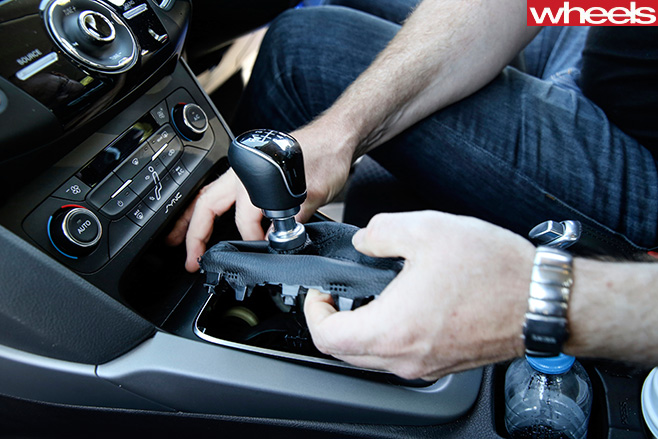
Ford Focus Sport hatch Price as tested: $26,910 Part 3: 1065km @ 7.1L/100km Overall: 4364km @ 7.8L/100km Odometer: 7383km Date acquired: December 2015
Update 3: Inflated worth
The third leg of the driving enjoyment trifecta.
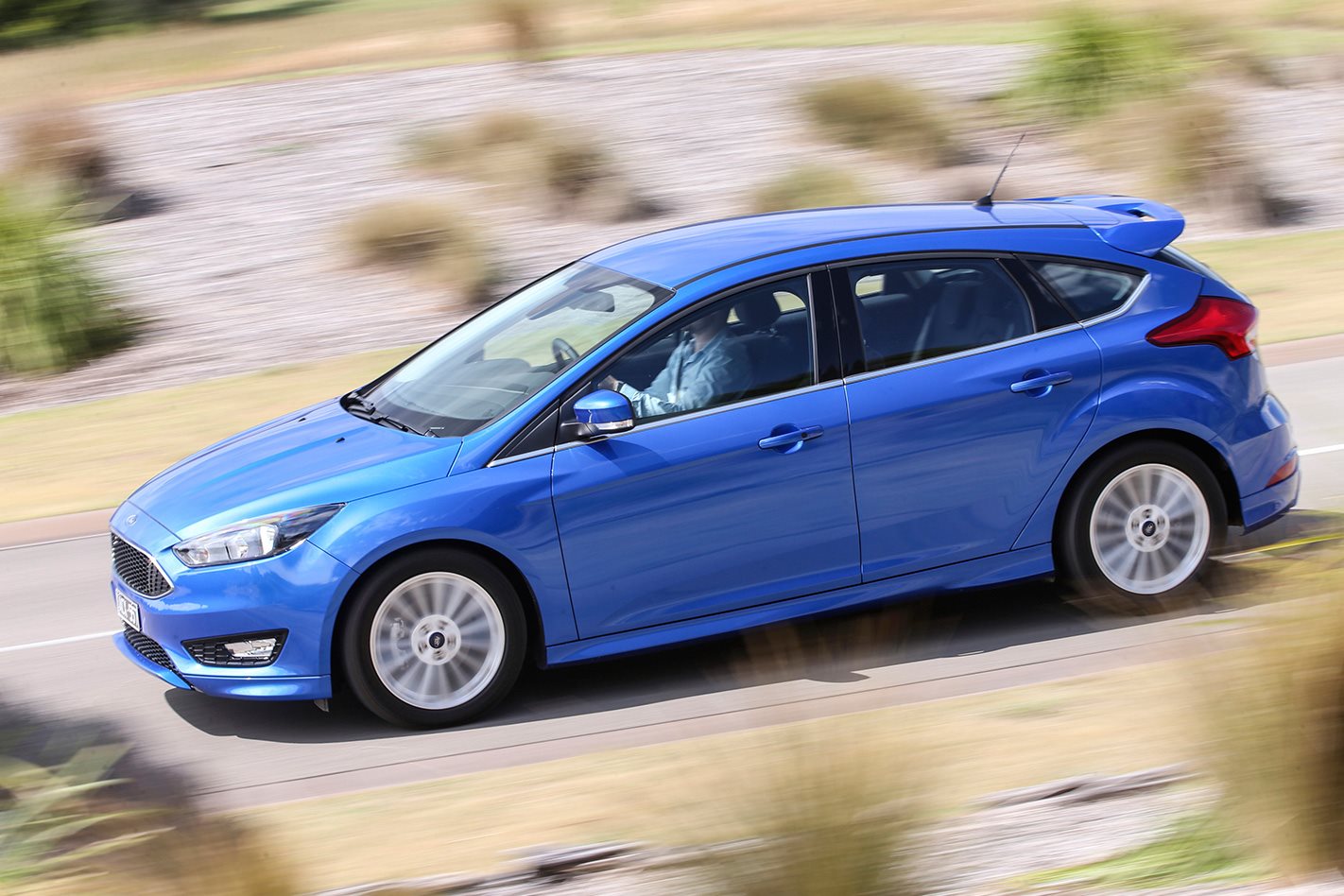
I’VE been told that I’m sensitive, which is why I don’t read the comments beneath any online story that I’ve written. And perhaps that may be where my Ford Focus Sport and I have a bond and fondness for each other.
The realisation came after I’d been away on several comparison tests (and if you’re reading this as a Blue Oval fan, that included the Mustang GT outmuscling the beloved Holden Commodore SS-V Redline).
I’d left the car at The Brunswick Office (otherwise known as Byron’s house), where it had hardly been driven. And, Your Honour,
I had not checked the tyre pressures for weeks before that…
So after enjoying the Mustang’s torque on brilliant country roads, as well as driving five seriously capable luxury saloons for this month’s comparo, the Focus had lost its edge. Or so I thought.
Instead of its typical eagerness and verve, the Focus felt a little flabby (again, a common point between me and the car).
So I checked how much air was in the Michelins, and it was only 27psi. Impressively, all four were at the same pressure, which was four pounds below the placard’s recommended 31psi.
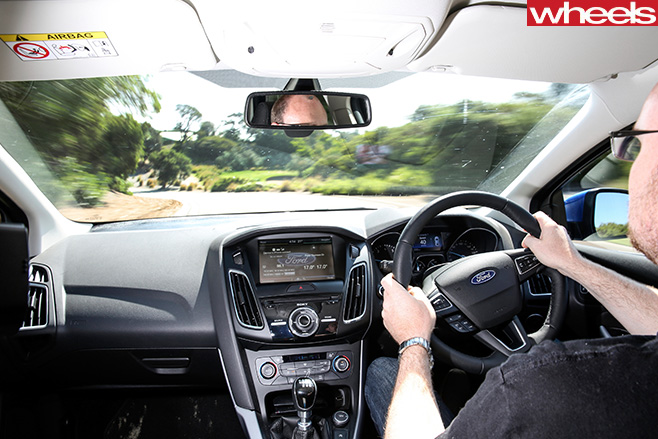
Now we were again carving up corners, settling quickly under brakes and giving excellent purchase off the mark.
I’ve mentioned how much I enjoy the Focus’s poke, and the fact that it requires technique off the mark for a successful launch. If you dump the clutch (ala Mustang) the 1.5-litre Turbo’s relative lack of torque sullies the attack. Get that clutch working spot on – which means a few revs and loading it up to its high bite point – and the take-off is brutal.
That seems to complete the trifecta of getting the most enjoyment from the Focus Sport. It’s super-sensitive to tyre pressures, so keep them in check even more closely than your Facebook account, and then there’s the driving technique.
These are the cornerstones of a car that’s deftly capable, even if it’s not quite as sharp as the previous model. Don’t say that within hearing range, though; we’re all a little sensitive.
Ghosts in the machine
A few months ago some rats must have nibbled into my log book because my fuel figures were up the creek, making the Focus Sport seem implausibly economical. Having traced back a couple of missing tankfuls of premium unleaded, my average consumption over the five months I’ve had the car is actually 10.4L/100km, not the 7.8 I last reported. My most humble apologies. I’ve since been publically flogged outside Bauer Towers and have only just healed sufficiently to ease back into those comfy bucket seats.
Ford Focus Sport hatch Price as tested: $26,910 Part 4: 1910km @ 9.5L/100km Overall: 6274km @ 10.4L/100km Odometer: 9293km Date acquired: December 2015
Update 4: Conclusion
One final weekend away provides an opportunity to make an assessment.

SIX hours. Alone. In the Focus. It was my way of farewelling the LZ Focus Sport manual hatch. It was also a chance to get to a level of intimacy that would reveal if, over the almost six months it had been ‘mine’, there were any skeletons lurking in the closet.
The 300-odd kilometre drive to Seaspray, a beachside town on 90 Mile Beach, for a lazy weekend was likely the last time I’d have the chance to clock so many miles in the Focus, which has proven utterly reliable the entire time – as you’d expect, yet still worth mentioning.
In all that time I hadn’t really sampled the stereo properly. The daily radio chatter in traffic needed to be met by a country road, amped-up rock-fest, with bad singing as I got lost in the music, the drive and the Focus. It’s a good system, especially at this price, but here’s a tip: don’t hit the ‘RDS’ button, which provides extra data but makes it sound tinny and cheap.

Once at speed, everything settles down; the engine is quiet, there’s little wind noise, and I’d find myself occasionally squeezing the steering wheel because it feels so good. Same goes for the driving position, and the overall agility around corners. The Focus has the talent to be refined yet raucous when needed.
I don’t have kids or even a dog, but the practicality of the back seats – which easily fold – fed my paranoia of not leaving anything visible to tempt passers-by. Up front, I particularly appreciated the massive door bins and centre console storage – though the covered bin is small and I foiled the sat-nav by packing it too tightly and knocking the SD card out (easily pushed back in).
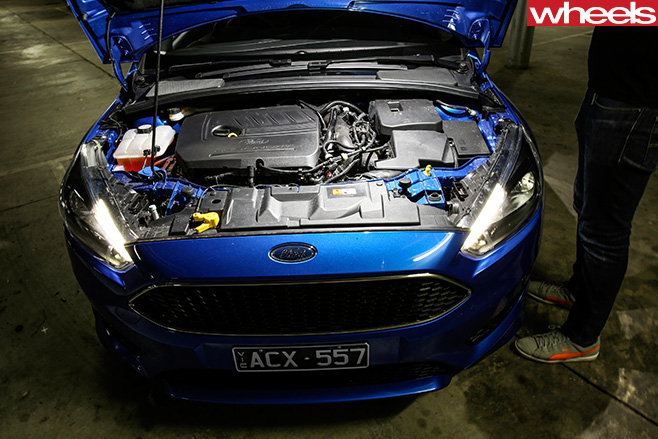
If you’re planning to buy the manual Sport model – or any manual Focus, since this engine does the entire non-performance Focus set – don’t expect class-leading economy, even on 98-octane.
What would I change about this car?
Those wheels are terrible to clean, and look dated. The seat trim is great, but I just don’t like the way it looks; it’s about the only area that makes this car feel cheap (well, that and the repeat offender – the gear lever boot).
And the windscreen wipers didn’t always clear the screen properly, which was especially problematic at night on a roo-infested country road.
Yet the gear this car comes with – reversing camera, sat-nav, keyless entry and start – means you don’t need to tick any of the options boxes. You won’t even need six hours, alone, to convince you that there are no skeletons in its closet.
Ford Focus Sport hatch Price as tested: $26,910 Part 5: 1340km @ 9.4L/100km Overall: 7414km @ 10.2L/100km Odometer: 10,633km Date acquired: December 2015

